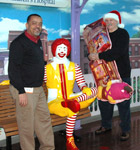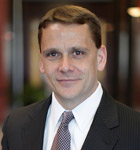Managing other people’s money is a scary business. Make the wrong decision and you could be responsible for the loss of hundreds of thousands of dollars. Make the right decision and clients tell their friends, who beat a path to your door. Either way, someone’s entire livelihood or retirement lies in your hands. So, when Fritz Harnsberger walked away from 17 years as a successful medical-device engineer in 1993, he had to feel really confident about his ability to manage investments—enough to forge an entire new career out of it. In those early days, quite frankly, his biggest obstacle was himself—trying to gain customers’ trust when he didn’t have an industry reputation to stand on. Little by little, however, Harnsberger made it his mission to make the right decisions and earn that trust. Today, his company, Marathon Investment Programs, has $36 million in assets under management.
I had an idea of how to build a model that would determine when to buy and sell. I had a friend in the industry. He said, “Fritz, if you develop a good investment vehicle, I’ll raise money for it.” That’s how I got started. In the beginning, I worked really hard. Some things worked. Some things didn’t. But, I enjoyed making the decisions myself. Today, clients are being referred to me by other professionals.
There’s a satisfaction in reaching a point where things aren’t as difficult as they used to be. Years ago, great care was invested in analysis of profit and capital preservation. In recent years, that investment is paying off. Expectations changed and things have been flowing our way. [It appears that] no longer is the market expected to provide continuous, long-term growth, but to only provide brief windows of opportunity. We continue to believe that the manager that rides those windows of opportunity without getting crushed in between will provide the best returns and the lowest volatility for clients.
There was a time in my investment career when clients were asking for less volatility in their portfolios. We were challenged to create steadier gains without taking a lot of risks or drawdowns (a decline in investment value). Significant drawdowns—say of 10 percent or more—make it hard to sleep at night. The basic challenge in this business is in trying to reduce volatility by investing in markets that are inherently volatile. The objective of creating less volatility can’t be reached by buying and holding investments like stocks and mutual funds for a long time because a security will eventually go through a period of disfavor. So, you have to be willing to sell when that happens. That’s managing risk.
Sometimes you have to rethink your thinking and redefine your priorities. When you do that, capital preservation becomes the first priority. That means analyzing portfolios on a monthly, weekly, and at times, on a daily basis. Also, to accumulate growth without experiencing volatility, you have to generate a portion of your overall gain from substantial dividends, not from stock growth.
One of the things we learned about creating low-volatility portfolios is that news about the economy doesn’t provide a good decision base. The market leads economic news by a good six to nine months, so by the time you get to the news, the market has already reacted to it. Today we have a great staff. There were many years when I worked alone. Things would have been easier if I had hired competent people sooner.

